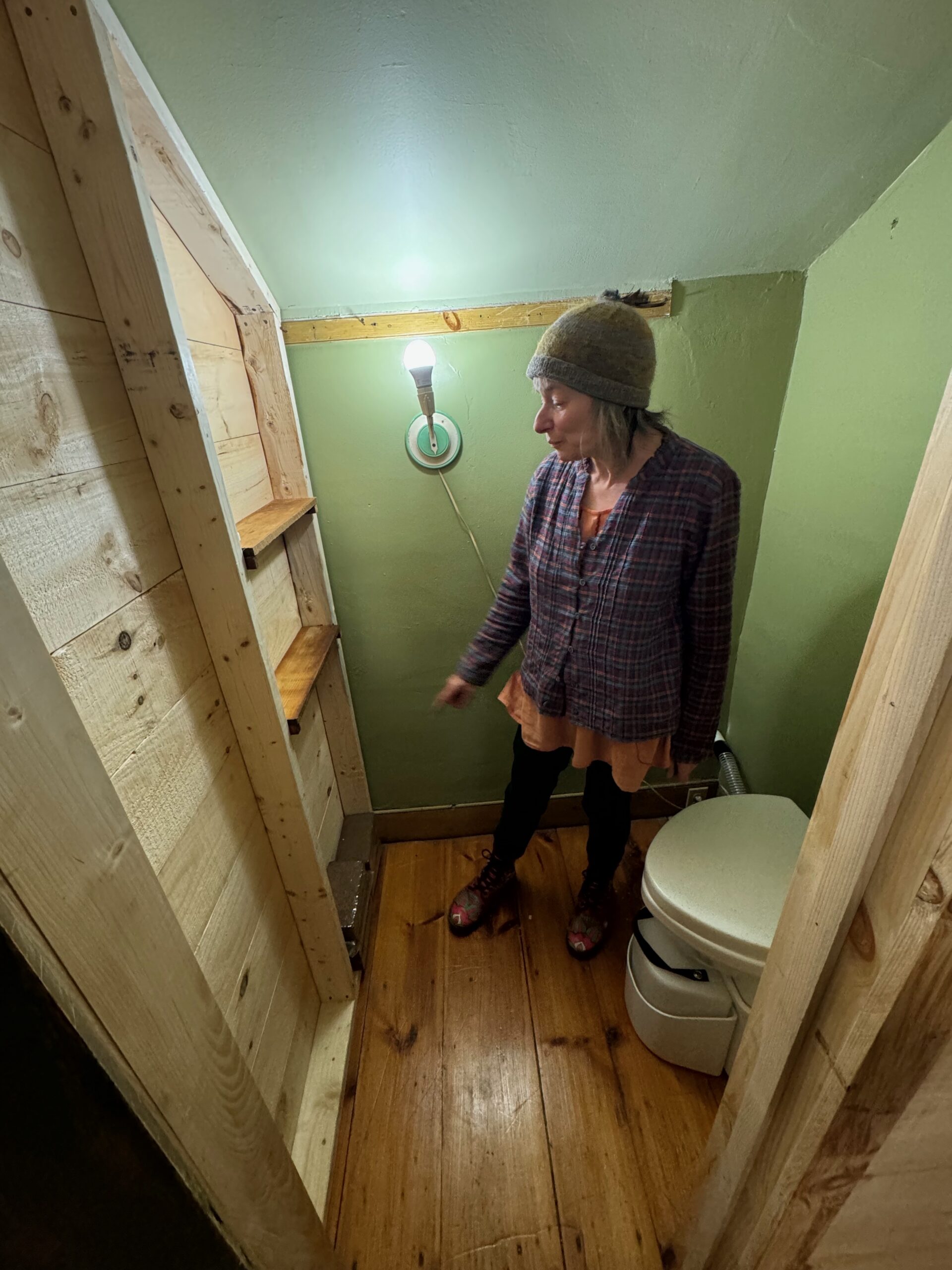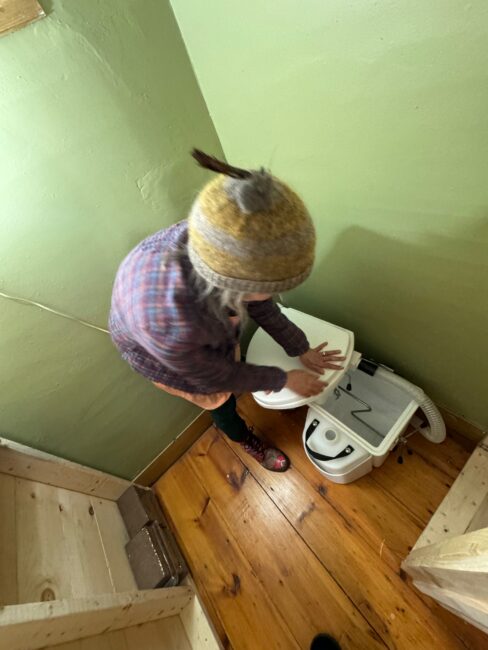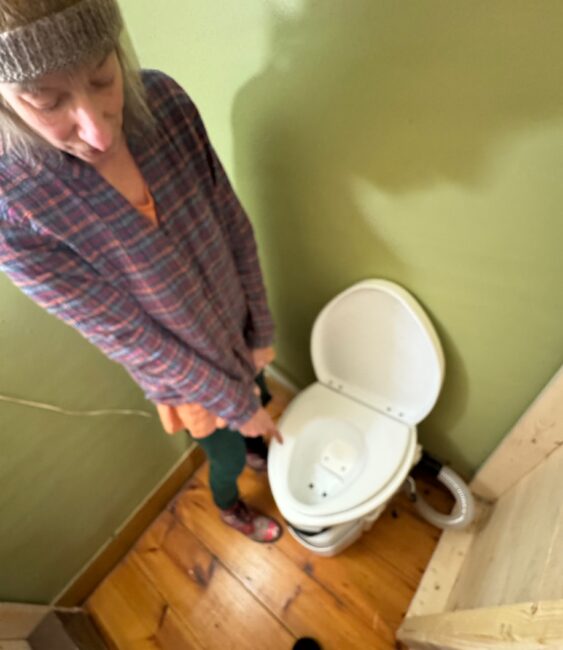We’re closing in on the final details of our compost toilet, which was months in the making.
Maria put some shelves in today. She plans to paint the interior white and the exterior the same green as the bedroom. I had a class with her this afternoon, and she explained how it would work. We’re also putting in a safety bar that she and I can grab if necessary.
The toilet is well built, drilled into the floor, strong, and easy to manipulate.
I am surprised at the simplicity of the toilet. There are two major elements to learn: urinating and bowel movements. Each uses a completely separate part of the toilet.
There are two holes for urinating and a larger hole for bowel movements. Since the toilet is upstairs, we only expect to use the former (I’m not used to writing about toilets, etc., but many people want to know) most of the time.
That means the composting material must only be changed every month or two.
We have a regular bathroom downstairs.
To prepare, we get a brick of coco coir, put it in a bucket, and add water until the coco coir is moist and absorbent.
It soaks for about 12 hours, and after any bowel movement, there’s a wheel to turn to open a large hole and mix the waste into the absorbent. You can use the wheel by sticking your hand out while on the toilet, which is sturdy and high enough for someone like me.
(Maria showing me how to lift the top and remove the urine bucket you can see it at the bottom)
The ventilation fan will also keep the absorbent coco coir moist. When the waste has to be removed, it can go to a compost site, which we have on the farm. When the waste is fully absorbed, it can be used in gardens.
Again, the bowel part will be occasional for us. The urine option will be used only at night, making life much easier for us.
This spares rushing down the stairs at night (unless I get sicker and can use it upstairs), using water or much electricity. The ventilation tube is very soft and quiet. We purchased the toilet for practical reasons, but the fact that it’s good for the environment is nice.
Urine will go into a bucket (separate from bowel movements) at the toilet’s base and can be easily slipped out to be emptied, washed, and replaced. No compost is necessary for the urine. Depending on use, the urinary bucket, a separate part of the toilet, can be changed every few days or weeks. It’s easy to remove.
Our compost (coco coir) must only be changed every two months unless used more frequently.
There are three ways odors are contained: the first is a ventilation tube, which will be plugged into the wall and running all the time, in use or not. The second is a tight lid that is closed after every use. The other odor blocker will be a mix of water and vinegar sprayed on the sides of the toilet bowl. That will stop an odor from the urine.
The ventilation is on to remove any odor (it feeds outside through a special tube that comes with the toilet), and the water/vinegar spray will neutralize any odor that appears.
So far, so good. The coco coir is soaking as I write this; everything else is set, plugged in, and ready. We are both fascinated and excited. We may end up using it tonight or, at the latest, tomorrow.
The photos show the holes for the urine and bowel movement. The urine will flow through the two smaller holes in the front of the seat. A side lever will open the larger holes for the feces right behind it. After eliminating, you turn a lever on the side three times to mix the bowel movement with the coco coir.
I’ll report back on how I went. Maria will go first and ensure we understand everything we need. I love the small room Dan Rogers built; we plan to brighten it up. Water and vinegar sprays go on the top. I have a feeling we are plunging into the future. These compost toilets are in great demand.
There are water shortages all over the country; this could help.




I stayed in a small cabin on an island off Vancouver Island that has electricity and a tap and sink and in a small extension a composting toilet. This was 10 or so years ago and there was NO odor in the toilet enclosure or cabin. It was great. Thank you for the ‘lesson’ on how it works. I love the floorboards, they are beautiful.
Thank you for this thorough explanation of how the toilet works. I’ve been thinking about getting one, but I’ve been waiting to read about your experience with it before I buy one.
I’ll keep you posted, Larry, thanks for the interest..
I am really interested in your field testing this toilet. I saw a new series on HULU? that is using something like this in remote houses with no indoor plumbing, but not once explained how the application worked. I am interested in getting something like this for my shed.
It is very popular now for small houses tat cant accomodate much construction, and old houses that weren’t made for modern plumbing. It costs a fortune to change old plumbing. These are being used in camps and remote houses but more and more in newer homes that want to use less water and also want to give a hand to Mother Earth. If it works the way is seems to work, we will be very happy. But I’ll be honest about it if it isn’t. Stay tuned..
Great article. We grew up on a farm and used daily or so ashes from the wood stove to cover bm s in the outdoor toilet. Every so often Dad shoveled it out and spread it on the cropland as fertilizer.
Btw my doctor said always to close toilet lids when flush. That bacteria viruses spread wirse otherwise, including covid.
(Today so much of the land is too Ed by chemicals, DDT, that green algae slime.)
Hi. Thank you for this post. We use a small composting toilet at our camp in the Adirondacks – question for you: Does yours use electricity? Ours does not – so asking yo find out if your very helpful tips will apply to our toilet. Many thanks. Lynne
Yes but only for ventilation
Is toilet paper a part of the equation? If so, does it need to go in a separate bin rather than mixed in with the Coir? We have a small camping toilet and everything, including toilet paper, gets hand pumped into the lower part of the toilet that we empty out at designated pump out areas at campsites, or pouring out in campsite outhouses. I love the idea of the water and vinegar solution to spray in the bowl. I’ll use that technique from now on in our little mobile toilet. Thank you for all the information.
Toilet paper goes in with the bowel movement material into the designated box
Liz, toilet paper is part of the equation. They recommend using the least expensive toilet paper, the good stuff doesn’t absorb as easily. Toilet paper can drop into the compost box at the bottom, it will disintegrate after a couple of weeks.
Very interesting. I have heard of folks using this type of toilet in RVs so they don’t have “black water” aka sewage to dispose of. Looking forward to reports on how it is performing. And thanks for not posting a photo of Maria sitting on the toilet 🙂
Compost Toilets: Your interested readers might want to check out “Gone With The Wynns” on YouTube who are a young couple traveling the world in a sailing catamaran and previously America in a RV motorhome. If you look or search in one of their archived blogs, they video and demonstrate a perfect explanation of various types of compost toilets and different ways to use them. It will answer any lingering questions one might have about this efficient method of human waste collection and removal. Very professionally done as well.